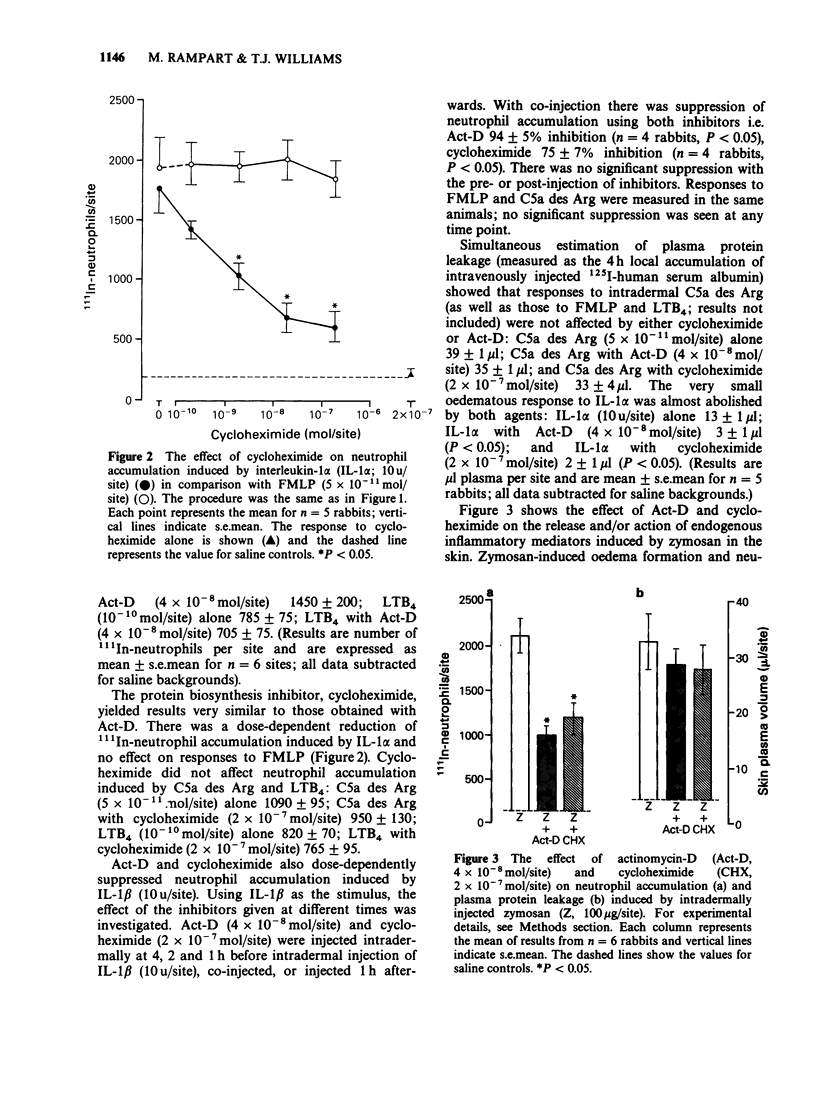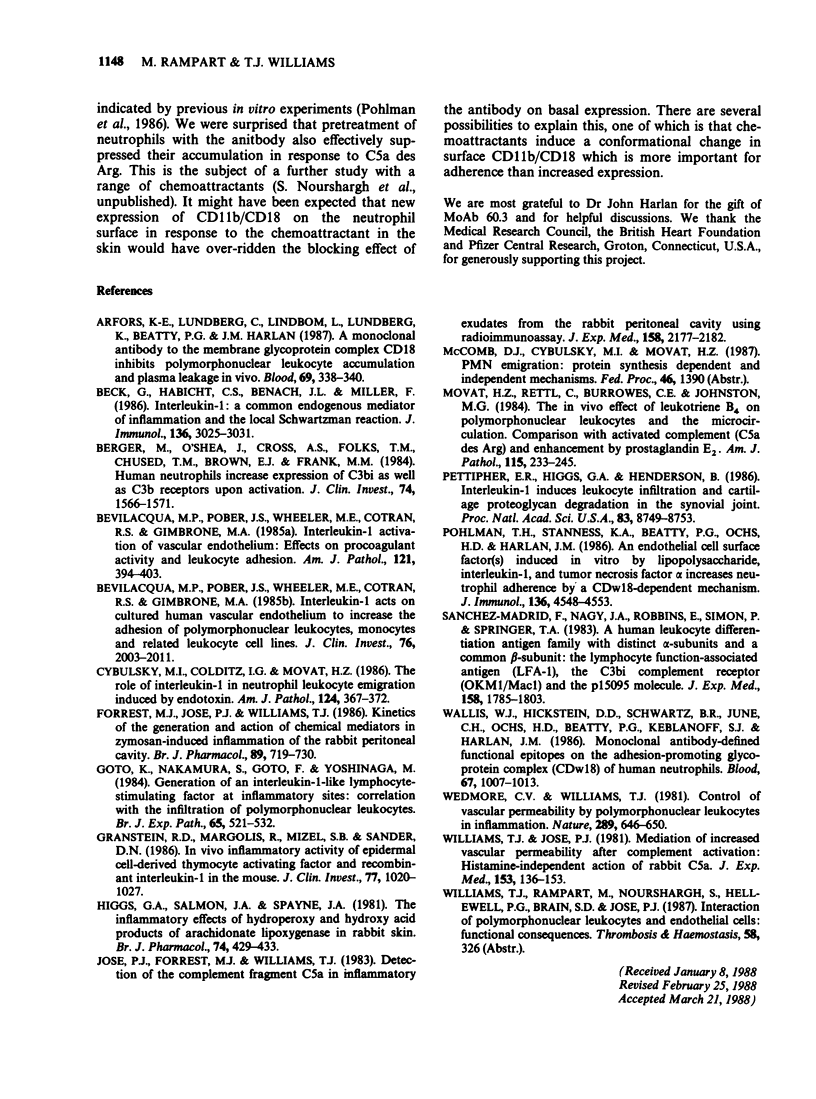Abstract
1. Mechanisms involved in neutrophil accumulation induced by intradermal injection of interleukin-1 (IL-1) in the rabbit were investigated using intravenously-injected 111In-labelled neutrophils. C5a des Arg, N-formyl-methionyl-leucyl-phenylalanine (FMLP) and leukotriene B4 (LTB4) were included for comparison. 2. Local inhibition of protein biosynthesis in the skin using actinomycin-D or cycloheximide blocked 111In-neutrophil accumulation induced by IL-1, but not that induced by the other mediators. 3. Actinomycin-D and cycloheximide had no effect on local plasma protein leakage induced by intradermally-injected C5a des Arg, or that induced by zymosan. 111In-neutrophil accumulation induced by zymosan was, however, partially suppressed. 4. A monoclonal antibody, MoAb 60.3, recognising neutrophil surface CD18 antigen, was preincubated with 111In-neutrophils before intravenous injection. This pretreatment did not affect circulating numbers of radiolabelled cells, but it inhibited their accumulation in response to IL-1, C5a des Arg and the other mediators. 5. The results suggest that neutrophil accumulation induced by IL-1, but not the other mediators, requires local protein biosynthesis, probably in the microvascular endothelium. Neutrophil accumulation to IL-1 and the other mediators appears to require neutrophil surface antigen, CD18. The inflammatory response to zymosan may be mediated by both endogenous C5a des Arg and IL-1.
Full text
PDF





Selected References
These references are in PubMed. This may not be the complete list of references from this article.
- Arfors K. E., Lundberg C., Lindbom L., Lundberg K., Beatty P. G., Harlan J. M. A monoclonal antibody to the membrane glycoprotein complex CD18 inhibits polymorphonuclear leukocyte accumulation and plasma leakage in vivo. Blood. 1987 Jan;69(1):338–340. [PubMed] [Google Scholar]
- Beck G., Habicht G. S., Benach J. L., Miller F. Interleukin 1: a common endogenous mediator of inflammation and the local Shwartzman reaction. J Immunol. 1986 Apr 15;136(8):3025–3031. [PubMed] [Google Scholar]
- Berger M., O'Shea J., Cross A. S., Folks T. M., Chused T. M., Brown E. J., Frank M. M. Human neutrophils increase expression of C3bi as well as C3b receptors upon activation. J Clin Invest. 1984 Nov;74(5):1566–1571. doi: 10.1172/JCI111572. [DOI] [PMC free article] [PubMed] [Google Scholar]
- Bevilacqua M. P., Pober J. S., Wheeler M. E., Cotran R. S., Gimbrone M. A., Jr Interleukin 1 acts on cultured human vascular endothelium to increase the adhesion of polymorphonuclear leukocytes, monocytes, and related leukocyte cell lines. J Clin Invest. 1985 Nov;76(5):2003–2011. doi: 10.1172/JCI112200. [DOI] [PMC free article] [PubMed] [Google Scholar]
- Bevilacqua M. P., Pober J. S., Wheeler M. E., Cotran R. S., Gimbrone M. A., Jr Interleukin-1 activation of vascular endothelium. Effects on procoagulant activity and leukocyte adhesion. Am J Pathol. 1985 Dec;121(3):394–403. [PMC free article] [PubMed] [Google Scholar]
- Cybulsky M. I., Colditz I. G., Movat H. Z. The role of interleukin-1 in neutrophil leukocyte emigration induced by endotoxin. Am J Pathol. 1986 Sep;124(3):367–372. [PMC free article] [PubMed] [Google Scholar]
- Forrest M. J., Jose P. J., Williams T. J. Kinetics of the generation and action of chemical mediators in zymosan-induced inflammation of the rabbit peritoneal cavity. Br J Pharmacol. 1986 Dec;89(4):719–730. doi: 10.1111/j.1476-5381.1986.tb11176.x. [DOI] [PMC free article] [PubMed] [Google Scholar]
- Goto K., Nakamura S., Goto F., Yoshinaga M. Generation of an interleukin-I-like lymphocyte-stimulating factor at inflammatory sites: correlation with the infiltration of polymorphonuclear leucocytes. Br J Exp Pathol. 1984 Oct;65(5):521–532. [PMC free article] [PubMed] [Google Scholar]
- Granstein R. D., Margolis R., Mizel S. B., Sauder D. N. In vivo inflammatory activity of epidermal cell-derived thymocyte activating factor and recombinant interleukin 1 in the mouse. J Clin Invest. 1986 Mar;77(3):1020–1027. doi: 10.1172/JCI112354. [DOI] [PMC free article] [PubMed] [Google Scholar]
- Higgs G. A., Salmon J. A., Spayne J. A. The inflammatory effects of hydroperoxy and hydroxy acid products of arachidonate lipoxygenase in rabbit skin. Br J Pharmacol. 1981 Oct;74(2):429–433. doi: 10.1111/j.1476-5381.1981.tb09988.x. [DOI] [PMC free article] [PubMed] [Google Scholar]
- Jose P. J., Forrest M. J., Williams T. J. Detection of the complement fragment C5a in inflammatory exudates from the rabbit peritoneal cavity using radioimmunoassay. J Exp Med. 1983 Dec 1;158(6):2177–2182. doi: 10.1084/jem.158.6.2177. [DOI] [PMC free article] [PubMed] [Google Scholar]
- Movat H. Z., Rettl C., Burrowes C. E., Johnston M. G. The in vivo effect of leukotriene B4 on polymorphonuclear leukocytes and the microcirculation. Comparison with activated complement (C5a des Arg) and enhancement by prostaglandin E2. Am J Pathol. 1984 May;115(2):233–244. [PMC free article] [PubMed] [Google Scholar]
- Pettipher E. R., Higgs G. A., Henderson B. Interleukin 1 induces leukocyte infiltration and cartilage proteoglycan degradation in the synovial joint. Proc Natl Acad Sci U S A. 1986 Nov;83(22):8749–8753. doi: 10.1073/pnas.83.22.8749. [DOI] [PMC free article] [PubMed] [Google Scholar]
- Pohlman T. H., Stanness K. A., Beatty P. G., Ochs H. D., Harlan J. M. An endothelial cell surface factor(s) induced in vitro by lipopolysaccharide, interleukin 1, and tumor necrosis factor-alpha increases neutrophil adherence by a CDw18-dependent mechanism. J Immunol. 1986 Jun 15;136(12):4548–4553. [PubMed] [Google Scholar]
- Sanchez-Madrid F., Nagy J. A., Robbins E., Simon P., Springer T. A. A human leukocyte differentiation antigen family with distinct alpha-subunits and a common beta-subunit: the lymphocyte function-associated antigen (LFA-1), the C3bi complement receptor (OKM1/Mac-1), and the p150,95 molecule. J Exp Med. 1983 Dec 1;158(6):1785–1803. doi: 10.1084/jem.158.6.1785. [DOI] [PMC free article] [PubMed] [Google Scholar]
- Wallis W. J., Hickstein D. D., Schwartz B. R., June C. H., Ochs H. D., Beatty P. G., Klebanoff S. J., Harlan J. M. Monoclonal antibody-defined functional epitopes on the adhesion-promoting glycoprotein complex (CDw18) of human neutrophils. Blood. 1986 Apr;67(4):1007–1013. [PubMed] [Google Scholar]
- Wedmore C. V., Williams T. J. Control of vascular permeability by polymorphonuclear leukocytes in inflammation. Nature. 1981 Feb 19;289(5799):646–650. doi: 10.1038/289646a0. [DOI] [PubMed] [Google Scholar]
- Williams T. J., Jose P. J. Mediation of increased vascular permeability after complement activation. Histamine-independent action of rabbit C5a. J Exp Med. 1981 Jan 1;153(1):136–153. doi: 10.1084/jem.153.1.136. [DOI] [PMC free article] [PubMed] [Google Scholar]


